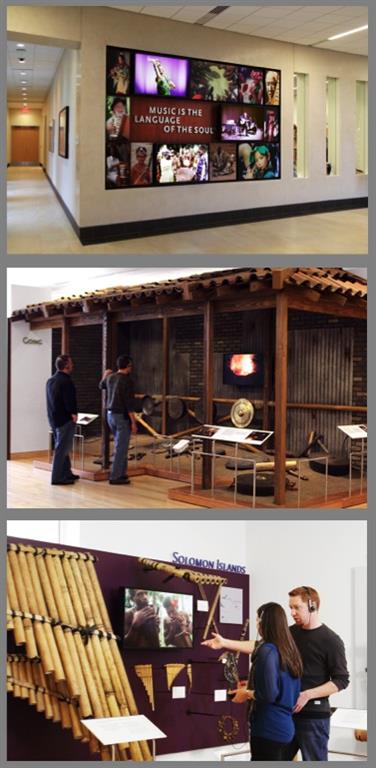Introduction
A world museum enthusiast, Robert Ulrich, former CEO of Target Corporation, visited the Musical Instrument Museum in Brussels, Belgium with friend Marc Felix several years ago. The trip sparked a unique vision to create a similar museum in the United States that would bring musical instruments to life and allow visitors to experience them within their cultural context. With that, the Musical Instrument Museum (MIM) was born, and so began brainstorming, research and construction.
MIM exists to enrich the world community by collecting, preserving and making accessible high-quality musical instruments, images and music from every country in the world. In order to celebrate the diversity of the world’s musical cultures and foster global understanding, MIM strives to offer guests an incomparable interactive experience through a welcoming environment, dynamic programming and exceptional musical performances.
Challenge
Ulrich’s passion for the art was evident throughout the process of building MIM. He not only wanted visitors to hear the music with premium wireless headsets, but see the instruments being played within their cultural context. His belief was that these elements would provide an educational, well-rounded experience for visitors.
Ulrich brought on Mark McCauley to head the technology department. Coming from an IT background, McCauley knew the integration of audio and video was a crucial aspect of creating MIM. Building the facility from scratch proved to be a major challenge as well as a benefit since McCauley and his team were able to incorporate technology with the most appropriate methods.
“From the start, we knew we needed relevant content because video was critical to our development and without suitable content, there would be no point in installing digital displays,” said McCauley, founding Director of Technology at MIM. “The most challenging aspect of creating MIM was the simultaneous planning, design, collecting and building of the facility. We were truly looking for a technology partner that could help us deliver an effective solution.”
McCauley had to deliver that solution to 300 exhibits that are broken down into ten galleries, taking visitors around the world. It would require a variety of screen sizes, full HD resolution and sustainability for years to come. Commercial-grade quality was also desired due to the 10-14-hour days the museum operates on 363 days of the year, not to mention any after-hours events that may occur. McCauley also stressed the importance of a 3-year warranty with 24-hour exchange in the event a monitor went down. With video an integral aspect of the visitor experience, McCauley also wanted to have extra displays on hand so that a problem could be fixed within minutes if necessary.
Not only were displays required in the galleries, but also in the boardroom, multi-purpose room, orientation gallery, theater, welcome wall and ticketing area. Careful consideration of projection technology was deemed inconsistent with the look and feel of the rest of the museum, so large screen size availability was of significant importance.
Solution
Although McCauley considered different vendors, consultant Tom Schneider’s experience with NEC displays at Target retail stores was enough to solidify the decision for MIM. He assessed the value of NEC and its ability to meet the museum’s stringent requirements. Availability was critical as the building needed to be up and running for its April 2010 grand opening. Phase 1 was completed in February 2010 with NEC the display vendor standard.
Upon entering MIM, visitors are greeted by an eye-catching graphic wall, featuring three 52” NEC LCD5220 displays. Another three of these models are used behind the ticketing counter, displaying the museum’s admission prices, upcoming performances and guest policies. Additional messaging and promotional content can be found on displays installed in alcoves throughout MIM’s hallways.
MIM’s multi-purpose room, which functions as a meeting space, corporate event location, client cocktail reception area and theater overflow, features two 65” MultiSync LCD6520 displays in both landscape and portrait orientation. These orientations allow the room to accommodate a variety of users with differing needs.
MIM also uses 52” and 23” displays outside its conservation lab, which is protected by a glass barrier. This window allows visitors a peek inside the conservation process while instruments are prepared for galleries and primped for maintenance.
“We knew we made the right choice with NEC when almost two years into their use, not one display has failed,” said McCauley. “Instead, those extra swap units we purchased are occupying a storage closet, which is a good problem to have.”
MIM’s complimentary wireless audio headsets offer metrics that provide MIM staff with the top and bottom 10 visited exhibits throughout the museum, including time spent in each area. With this data, McCauley found that the areas without video content were the least visited exhibits. He quickly worked directly with NEC sales to order displays in those areas during phase 2 of MIM’s construction. The installation was done solely by MIM staff.
Recently, MIM upgraded its 65” displays to NEC’s 70” P701. The additions of DisplayPort connectivity, Ethernet for remote monitoring and 15% increased screen surface with the same low level of power consumption were attributes that lead to the switch. The MIM corporate boardroom and orientation gallery both utilize this model. In total, the museum uses 423 NEC displays throughout its space.
“Coordinating video with the audio segments give the museum an extra dimension,” said McCauley. “By providing both audio and visual content, MIM has fulfilled its mission of bringing the world’s music to life.”
Discussions and planning for the next phase have already begun. As a nonprofit, MIM is considering adding digital signage to the monetary donor wall, dining area and bookstore, as well as supplementing its facility with kiosks to supply a solution that caters to today’s age of self-service and efficiency.










